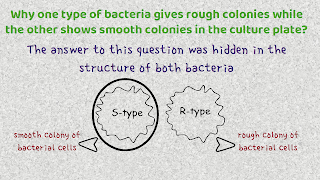Frederick Griffith
Griffith's experiment was a stepping stone for the discovery of genetic material. His experiments were conducted with a bacteria, Streptococcus pneumonia. He observed the transfer of genetic material.
Streptococcus pneumonia is a bacteria that is responsible for pneumonia. Griffith observed two types of this bacteria, one that gives in a culture plate a smooth shiny colony while the other gives rough colonies in the culture plate.
Griffith called the smooth colony of bacteria S-type bacteria while the rough colony of bacteria is R-type bacteria.
Now, the question is why one type of bacteria gives rough colonies while the other shows smooth colonies in the culture plate.
The answer to this question was hidden in the structure of both bacteria, smooth bacteria or S-type bacteria have an outer protective covering around them while R-type bacteria miss that protective layer.
Because of this outer covering, S-type bacteria show a smooth colony of bacterial cells while R-type bacteria did not show this smooth appearance in the culture plate.
Griffith conducted his experiment in 1928, with mice.
Experiment.
- Griffith takes both S-type and R-type bacteria of streptococcus pneumonia.
- He took a mouse and infected it with R-type bacteria.
- The mice remained alive after this infection.
- Then he inserted S-type bacteria within the mice.
- The mice died.
Now, why did mice live alive with an R-type strain of bacteria while had died with an S-type strain?
The R-type strain of bacteria is non-virulent and thus cannot cause infection. While the S-type strain of bacteria has a protective covering around it which makes it virulent and so mice died when treated with S-type.
- He killed the S-type bacteria with heat.
- He inserted the strains of this heat-killed bacteria inside the mice.
- The mice will remain alive.
- Then he took both R-type bacteria and S-type and inserted them in mice.
- The mice died.
This looks strange for Griffith because both R-type and heat-killed S-type bacteria are non-virulence and mice remain alive when both are separately treated with mice.
He concluded the following results from his experiment.
Conclusion.
Griffith concluded from his experiment that something was present in heat-killed bacteria that transferred toward R-type bacteria and made R-type bacteria infectious.
- Now, how can Griffith say that the material transfer from heat-killed S-type strain to R-type strain?
- And, why this transformation did not occur from the R-type strain to the heat-killed S-type strain?
Well, the simplest answer to both these questions is that he found an R-type strain from the body of dead mice, which were virulent. So, he concluded that something was transferred from heat-killed S-type to R-type, and made the R-type strain virulent.
However, Griffith was unable to describe what is moving out from heat-killed S-type bacteria to R-type bacteria. But he was sure that it must be genetic material.
This mystery was solved later by Oswald Avery, Colin MacLeod, and Maclyn McCarty.

.png)








.png)
.png)
.png)
%C2%A0.png)
.png)
.png)


.png)

0 Comments